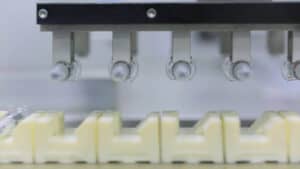As the most common cutting tool in hole machining, drill bit is widely used in mechanical manufacturing, especially for the machining of holes in parts such as cooling devices, tube sheets of power generation equipment, and steam generators. Its application is particularly extensive and important.
In this article, we will take you to understand what kind of precision standards can be achieved in drilling holes in CNC machining, and the factors that affect drilling precision.
Drilling accuracy standard
The accuracy of the hole is mainly composed of factors such as aperture size, position accuracy, coaxiality, roundness, surface roughness, and orifice burrs. However, the machining accuracy of drilling is low, generally it can only reach IT10, and the surface roughness is generally 12.5-6.3 μm.
In the process of drilling pin holes, the drill bit usually has two main cutting edges. During processing, the drill bit cuts while rotating. The rake angle of the drill bit becomes larger and larger from the central axis to the outer edge, and the cutting speed of the drill bit is higher as it gets closer to the outer circle, and the cutting speed decreases to the center, and the cutting speed of the rotating center of the drill bit is zero. The chisel edge of the drill bit is located near the axis of the rotation center, the chisel edge has a large auxiliary rake angle, no chip space, and the cutting speed is low, so it will generate a large axial resistance. If the chisel edge is ground to type A or type C in DIN1414, and the cutting edge near the central axis has a positive rake angle, the cutting resistance can be reduced and the cutting performance can be significantly improved.
Factors Affecting Drilling Accuracy
① Clamping accuracy and cutting conditions of the drill bit, such as tool holder, cutting speed, feed rate, cutting fluid, etc.;
②Drill size and shape, such as drill length, blade shape, drill core shape, etc.;
According to different workpiece shapes, materials, structures, functions, etc., drills can be divided into many types, such as high-speed steel drills (twist drills, group drills, flat drills), solid carbide drills, indexable shallow hole drills, deep hole drills, etc. Drills, trepanning drills and replaceable head drills, etc.
③The shape of the workpiece, such as the shape of the side of the hole, the shape of the hole, the thickness, the state of the clamping, etc.
Due to the vibration of the drill bit, the drilled hole pattern is easily polygonal, and lines like rifling lines appear on the hole wall. Common polygonal holes are mostly triangular or pentagonal. The reason for the triangular hole is that the drill bit has two centers of rotation when drilling, and they vibrate at a frequency of 600 times. The main reason for the vibration is the unbalanced cutting resistance. Well, the resistance force is unbalanced during the second round of cutting, and the last vibration is repeated again, but the vibration phase has a certain offset, resulting in rifling lines on the hole wall. When the drilling depth reaches a certain level, the friction between the edge face of the drill bit and the hole wall increases, the vibration attenuates, the rifling line disappears, and the roundness becomes better.
This type of hole is funnel-shaped from the longitudinal section. For the same reason, pentagonal and heptagonal holes may also appear during cutting.
Hope the above content can help you!




